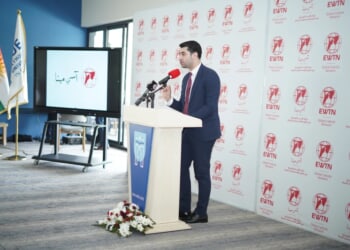In the real world, the lack of a compact, high-capacity power solution ensured that the TALOS suit was little more than a pipe dream by the time it was canceled in 2019.
Marvel’s 2008 film Iron Man is widely considered by fans and critics alike to be the best of all the Marvel comic book films. The iconic film launched one of the world’s most successful media franchises. It also apparently had a degree of influence in a massively expensive—though ultimately failed—covert military technology program.
In 2013, the United States Special Operations Command (SOCOM) undertook an ambitious effort to create a “supersuit” akin to what audiences saw Robert Downey, Jr’s iconic superhero wearing in the 2008 film. The final product came to be known as the Tactical Assault Light Operator Suit, or “TALOS” for short—but, as one might expect, was a far cry from the screen version.
How Adidas Became a Defense Contractor
There were other partners on the TALOS program, including the Defense Advanced Research Projects Agency (DARPA), the U.S. Army Research, Developing, and Engineering Command (RDECOM), and private firms like Raytheon, Lockheed Martin, and Revision Military.
Apparently, Adidas, the shoe and sports apparel company, was involved, too—illustrating the absurdity of the defense contracting process. Said one defense expert at the time that TALOS was announced, “It’s more than just a suit, it’s more than Hollywood, it’s more than us doing interviews in the media. It’s about changing the way we do acquisitions.”
Yeah, sure.
The overall budget for the TALOS program was approximately $80 million over four years—a relatively paltry sum when compared to other next-generation weapons platforms, such as the F-35 or F-22 fifth-generation warplanes.
But even at the time of the system’s announcement, critics argued that the $80 million price tag was insufficient to achieve the program’s ambitious goals, especially given the rapid development timeline—aiming for a prototype by 2014 and an operational suit by 2018.
Did the Military Really Need a TALOS Suit?
TALOS was born out of the need to address the vulnerabilities that U.S. Special Forces operators were encountering in the Global War on Terror (GWoT).
Specifically, TALOS was meant to overcome the complications operators were experiencing in breaching fortified positions. U.S. Navy Admiral William McRaven, who was serving as the head of SOCOM in May 2013, announced the TALOS initiative at a conference, emphasizing the goal of creating a suit that would provide unprecedented protection and performance.
According to the TALOS program’s supporters, modern warfare demanded enhanced survivability against small arms fire, shrapnel, and other battlefield threats—as well as improved situational awareness and physical endurance. Think of it as doing for the warfighter what the F-22A Raptor did for the warplane: turn it into a powerful battlefield sensor that could obliterate almost any target it faced.
SOCOM wanted the TALOS supersuit to integrate advanced armor, sensors, communications, and exoskeleton technology to create a holistic combat platform for elite forces, particularly units like SEAL Team Six (DEVGRU). Maybe Iron Man is the wrong way to think about such a suit; envision it instead as a cross between Iron Man, Master Chief from Halo, and even Ellen Ripley from the final fight sequence in Aliens.
The TALOS Suit Was Designed to Do Everything
The TALOS supersuit was to be bulletproof, weaponized, and capable of monitoring the wearer’s vital signs, all while providing enhanced strength, agility, and situational awareness. Engineers posited that TALOS would provide three times the amount of coverage that standard body armor did. What’s more, the supersuits were supposed to be designed with a low-profile to reduce the physical burden of heavy loads.
Interestingly, the suits were not intended for entire squads. They were only designed for squad leaders in high-risk operations, emphasizing targeted protection and capability enhancement.
The armor on the TALOS supersuit incorporated next-generation ballistic protection, including lightweight polyethylene armor and experimental materials, like magnetorheological fluids, which could transition from liquid to solid in milliseconds when exposed to a magnetic field or electrical current.
This “liquid body armor,” developed by researchers at the Massachusetts Institute of Technology (MIT), promised to enhance protection while minimizing weight.
A core feature of the TALOS supersuit was its exoskeleton technology. It was meant to augment the operator’s strength and endurance by reducing the metabolic cost of carrying heavy loads (often exceeding 60-70 pounds). During sprints or long marches, the suits would enhance mobility.
While a full-body exoskeleton was initially envisioned, later iterations focused on lower-body systems to assist with running and load bearing, which could be shed before entering combat.
Embedded sensors were designed to monitor core body temperature, heart rate, hydration levels, and body position. These provided real-time data to both operator and medical personnel. In the event of injury, the suit could theoretically administer first-aid measures, such as wound-sealing foam or oxygen, to stabilize the operator until evacuation.
TALOS incorporated an advanced heads-up display that utilized 360-degree cameras with night vision. It also employed conformable antennas to enhance the wearer’s overall situational awareness. These systems aimed to integrate data from drones, reconnaissance aircraft, and other platforms, delivering a comprehensive view of the battlefield. The suit also explored 3D audio systems and non-visual information displays to reduce cognitive overload.
The TALOS Program’s Achilles Heel: A Power Source
One of the biggest complications for the program was developing a lightweight, self-contained power source capable of sustaining the suit’s systems for extended periods—up to 12 hours at 12 kilowatts.
In 2008’s Iron Man, this most vexing, basic problem of any supersuit was resolved through the creation of a fictional “arc reactor,” a deus ex machina. But in the real world, the lack of a compact, high-capacity power solution ensured that the TALOS suit was little more than a pipe dream by the time it was canceled in 2019.
But the dream never dies. Since TALOS’ cancellation, several spinoff technologies have been further developed.
For example, a lightweight polyethylene armor that provides 44 percent more body coverage than standard body armor—and is 25 percent lighter—is currently being combat-evaluated by select Special Forces units. Those physiological monitoring systems meant to track the well-being of the suit wearers in combat are being integrated into other combat platforms. What’s more, those lower-body exoskeletons are being tested by Lockheed Martin’s ONYX and FORTIS systems.
Oh, and Oculus founder-turned-defense contractor Palmer Luckey of Anduril announced that he had been experimenting with a cheaper, more efficient combat exoskeleton.
So, even though TALOS was never fully realized, key elements of the program continue today. This is especially noteworthy, as both China and Russia are developing their own exoskeletons. Most recently, in fact, China showcased a rather clunky domestically produced version of an exoskeleton.
So the race for the combat supersuit is well underway. Iron Man, or something resembling him, may just yet be showing up on tomorrow’s battlefields—especially as more actors involve themselves in the development of this technology and as the underlying systems continue development.
About the Author: Brandon J. Weichert
Brandon J. Weichert, a Senior National Security Editor at The National Interest as well as a contributor at Popular Mechanics, who consults regularly with various government institutions and private organizations on geopolitical issues. Weichert’s writings have appeared in multiple publications, including the Washington Times, National Review, The American Spectator, MSN, the Asia Times, and countless others. His books include Winning Space: How America Remains a Superpower, Biohacked: China’s Race to Control Life, and The Shadow War: Iran’s Quest for Supremacy. His newest book, A Disaster of Our Own Making: How the West Lost Ukraine is available for purchase wherever books are sold. He can be followed via Twitter @WeTheBrandon.
Image: Wikimedia Commons.


















